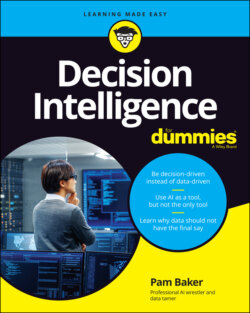Читать книгу Decision Intelligence For Dummies - Pamela Baker - Страница 24
Short Takes on Decision Intelligence
ОглавлениеIN THIS CHAPTER
Becoming familiar with the decision intelligence approach
Comprehending the method, principles, and priorities of decision intelligence
Working your way from design to reality
Seeing the difference an inverted V makes
Implementing for the win
Do you find yourself looking at a spreadsheet or viewing charts or gazing glassy-eyed at a fancy visualization that some bit of artificial intelligence magic has produced for you and wondering what you should do next? You’re not alone. Millions of other business and finance people are doing the same thing. So are legions of leaders and decision-makers in other industries.
While you’re trying to puzzle out which parts of those “actionable insights” being handed to you are in fact actionable and, if so, what action would apply, you’ve likely wished for something a bit more cut-and dried when it comes to determining what your organization would implement — and you certainly wouldn’t mind being considerably more certain about what's going to happen post-implementation.
Would your best bet in such a situation involve letting the miracle of artificial intelligence (AI, for short) make your decisions for you? Well, it turns out that AI isn’t so miraculous. In fact, an estimated 80 percent of all AI projects fail, where failure here is defined in terms of failing to deliver a measurable business value. That means most AI projects end up on the trash heap for leaning too heavily on the experimental side and being useless on the applied side.
It is painfully (and expensively) obvious that this strategy isn’t quite working out the way everyone hoped. An alternative approach is needed to make data more helpful and better aligned with consistently delivering business value. One such approach flips the model from data driven processes to decision driven processes. Known as decision intelligence, human and machine decision-making skills are combined with decision theory, decision sciences, and data sciences in a customizable mix that pins decisions to a precise and expected business value.
The concept isn’t entirely new — one of its oldest published mentions cropped up in 2002 in Uwe Hanning's scholarly paper “Knowledge Management + Business Intelligence = Decision Intelligence” — but it has evolved over time, incorporating long-accepted scientific formulas from several well-established sciences. This means its inner workings are well known and tested. Switching over to a decision intelligence approach is therefore no gamble — it's simply a supremely logical way for you to achieve the business outcomes you desire. Decision intelligence leaves little to chance, in either its own construct or the value it consistently delivers.
What differentiates one decision intelligence project from another is the talent and acumen of the decision makers at the helm. They make the recipe that cooks the business value into the process. And they decide when and whether to invite data and machines to the planning table.
Decision intelligence is highly agile and versatile. Decision makers can use it to make decisions either on the back of a napkin or with the help of the most sophisticated AI on the planet.
